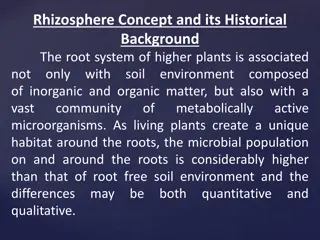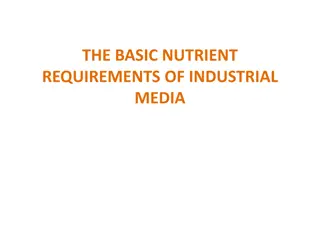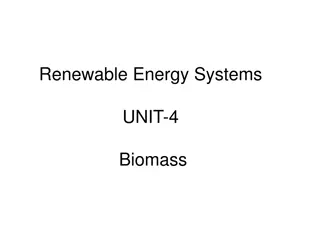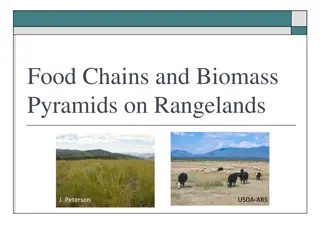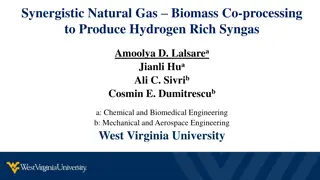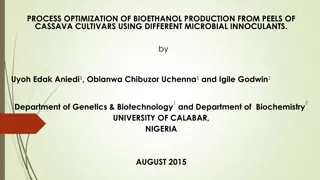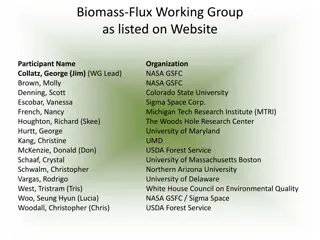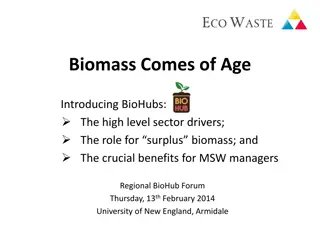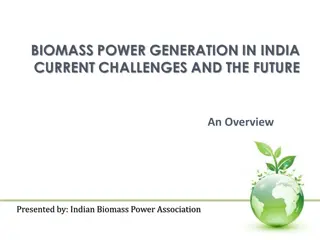Industrial Applications of Microbial Biomass Production
Microbial biomass has various industrial applications such as the production of single-cell proteins, antibiotics, ethanol, and organic acids. This biomass can serve as a valuable resource for seed cultures, silage production, biopesticides, animal fodder, and more. Yeasts like Saccharomyces cerevisiae play a crucial role in fermentation processes, utilizing substrates like molasses to produce biomass for different applications.
Download Presentation

Please find below an Image/Link to download the presentation.
The content on the website is provided AS IS for your information and personal use only. It may not be sold, licensed, or shared on other websites without obtaining consent from the author. Download presentation by click this link. If you encounter any issues during the download, it is possible that the publisher has removed the file from their server.
E N D
Presentation Transcript
In a few instances the cells i.e. biomass of microbes, has industrial application as listed in Table below. The prime example is the production of single cell proteins (SCP) which are in fact whole cells of Spirullina (an algae), Saccharomyces (a yeast) and Lactobacillus (a bacterium). The main aim has been the conversion of substrate into a useful primary or secondary metabolic product, such as antibiotics, ethanol and organic acids.
Microbial Biomass Production: Baker s yeast In most of the industrial fermentations the aim is to produce maximal bioproduct from the microbial biomass generated during fermentation. However, in some cases this biomass is the bioproduct e.g. a) seed culture for fermentations, b) silage production, c) biopesticdes, d)animal fodder, f) inoculants for bioleaching of minerals g) source of protein for humans.
The fermentation process involved for microbial biomass production is quite similar to classical fermentations used for production of a bioproduct with slight variations. This aspect will be explained by understanding the production of baker s yeast (Saccharomyces cerevisae) used for preparation of bread and in some cases inoculum for alcoholic beverages especially beer.
Factory Production 1- Substrate The substrate usually used for baker yeast production is molasses. Where these are not available or are too expensive any suitable sugar-containing substrate e.g. corn steep liquor may of course be used.
2- Fermentor processes The fermentor for baker s yeast propagation is nowadays made of stainless steel. The culture from slant is transferred to a small liquid medium contained in a glass conical flask. After incubation (28-30 C, shaking, 24-36 hrs), whole of the culture is transferred to a bigger culture flask and incubated. In this way 6-8 sub culturings, increasing the volume of culture medium nearly 10 folds at each step are done till enough inoculum is prepared.
Last two or three sub culturings are carried out in small to mid size fermenters. Fed batch mode of fermentation is preferred for production of yeast biomass. The fermentation medium comprises of molasses supplemented with nitrogen source (ammonium salts or urea), minerals and vitamins. The pH of the medium is adjusted to 4.0-4.5.
The fermentation is carried out in highly aerobic conditions (130-150mmol/L/hr). Fermentation process is considered complete when the nutrients get exhausted. The aerobic fermentation is continued for 30- 40 min. This period is called yeast ripening phase in which storage carbohydrate (trehalose) content increase and protein and RNA content decreases.
3- Harvesting the yeast Yeast cells are centrifuged to separate them from culture supernatant. Yeast biomass thus obtained is thoroughly washed with sterile water and chilled to 2-4 C. Final step involves the removal of moisture from the yeast cells, to increase their shelf life, by use of vacuum dehydrators. Adjusting biomass water content to (a) 70-73% (w/w) results in the formation of thick paste of biomass which is cut into one kg bricks and stored at 2-4 C or ( b) 5-10% (w/w) to form dried yeast which can be stored without refrigeration.
4- Packaging Baker s yeasts may be packaged as moist (compressed) yeasts or as dried active yeast. (i) Compressed yeast: The yeast product obtained after harvesting, is mixed with fine particles of ice, starch, fungal inhibitors and processed vegetable oils which all help to stabilize it. stored at 7 to 0 C and transported in refrigerated vans. (ii) Active dry yeast: Dry yeast is more stable in that it can be used in areas or countries where refrigeration is not available. The final product has a moisture content of about 8% and may be packaged in nitrogen-filled tins. Sometimes anti-oxidants may be added to the yeast emulsion to further ensure stability.
Role of Yeasts in Bread-making Methods of Leavening: Leavening is the increase in the size of the dough induced by gases during bread-making. The Process of Leavening: The events taking place in dough during primary fermentation i.e. fermentation before the dough is introduced into the oven may be summarized as follows. During bread making, yeasts ferment hexose sugars mainly into alcohol (0.48 gm) carbon dioxide (0.48 gm) and smaller amounts of glycerol (0.002-0.003 gm) and trace compounds (0.0005 gm) of various other alcohols, esters aldehydes, and organic acids.
The CO2 dissolves continuously in the dough, until the latter becomes saturated. Subsequently the excess CO2 in the gaseous state begins to form bubbles in the dough. It is this formation of bubbles which causes the dough to rise or to leaven. The total time taken for the yeast to act upon the dough varies from 2-6 hours or longer depending on the method of baking used
Flavor development The aroma of bread is distinct from those of the substances mentioned earlier because of the baking process. During baking the lower boiling point materials escape with the oven gases; furthermore, new compounds result from the chemical reactions taking place at the high temperature. The flavor compound found in bread are organic acids, esters, alcohols, aldehydes, ketones and other carbonyl compounds.
1 ) The organic acids include formic, acetic, propionic, n-butyric, isobutyric, isocapric, heptanoic, caprylic, pelargonic, capric, lactic, and pyruvic acids. 2) The esters include the ethyl esters of most of these acids as would be expected in their reaction with ethanol. Beside ethanol, amyl alcohols, and isobutanol are the most abundant alcohols. A good proportion of many of these is lost during baking.






